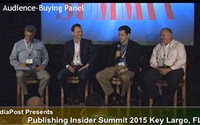DCN's Kint To Publishers: Don't Lose Sight Of Content As Audience-Buying Takes Over
- by Tyler Loechner @mp_tyler, April 30, 2015
 “[Publishers] are embracing programmatic,” asserted Jason Kint, CEO of Digital Content Next, at the Publishing Insider Summit in Key Largo, FL, this morning. “[But] the great
mistake that we make in digital is when we think of content only as the article, text or video, and we don’t think about the entire experience.”
“[Publishers] are embracing programmatic,” asserted Jason Kint, CEO of Digital Content Next, at the Publishing Insider Summit in Key Largo, FL, this morning. “[But] the great
mistake that we make in digital is when we think of content only as the article, text or video, and we don’t think about the entire experience.”
Kint was speaking on a panel focused on the “tectonic shift” currently taking place in digital advertising -- a shift from media selling to audience-buying.
“The content is every bit as important,” Kint added. “I would argue the biggest mistake a publisher can make is losing sight of that as we shift and we create more value with audiences.”
Kint was speaking on the panel just one day after DCN released a white paper meant to give digital publishers tips on prepping for the programmatic future. The white paper is based on interviews from 10 DCN member companies, including the New York Times, Washington Post, Hearst Digital Media, Vox Media and other premium publishers.
A key takeaway from the interviews, per DCN’s white paper, is that “programmatic is not a channel, but a broad set of automation and efficiency tactics that can be employed across a range of inventory.”
This clarification is needed, DCN claims, because programmatic was born synonymous with real-time bidding (RTB). “It was often thought to be a race to the bottom where audiences, disintermediated from content, could be bought at diminishing prices,” the white paper reads. In other words, programmatic was introduced to the digital ad industry as a channel to backfill unsold inventory. It will take time -- and the inclusion of more premium inventory in the marketplace -- for that notion to change.
“[Programmatic] started as a direct response, audience-based business, which is what most of digital is right now,” said Kint on the panel. “And what you’re going to see change in the coming years is those machines actually calibrating toward high-quality content, clean, well-lit environments, and brands that marketers and humans trust. That’s where the overall content experience will really matter.”
Kint’s advice serves as a reminder that just because the audience is now more visible, targetable and valuable, doesn’t mean the quality of content no longer matters -- and that programmatic technologies will eventually catch up to this fact, benefitting the publishers that never lost sight of quality content in the first place.
The panel can be seen in full below:
Broadcast live streaming video on Ustream



Kint is right: context counts! You wouldn't buy audiences in print without considering the pages your ad appeared on. Why should digital be different? At Twelvefold, we've found that understanding content is an efficient and effective way of reaching ideal audiences. We buy all our media programmatically, and place bids based on what people are reading or watching, versus who a cookie thinks they are. It's brand-safe and transparent, with enormous scale.